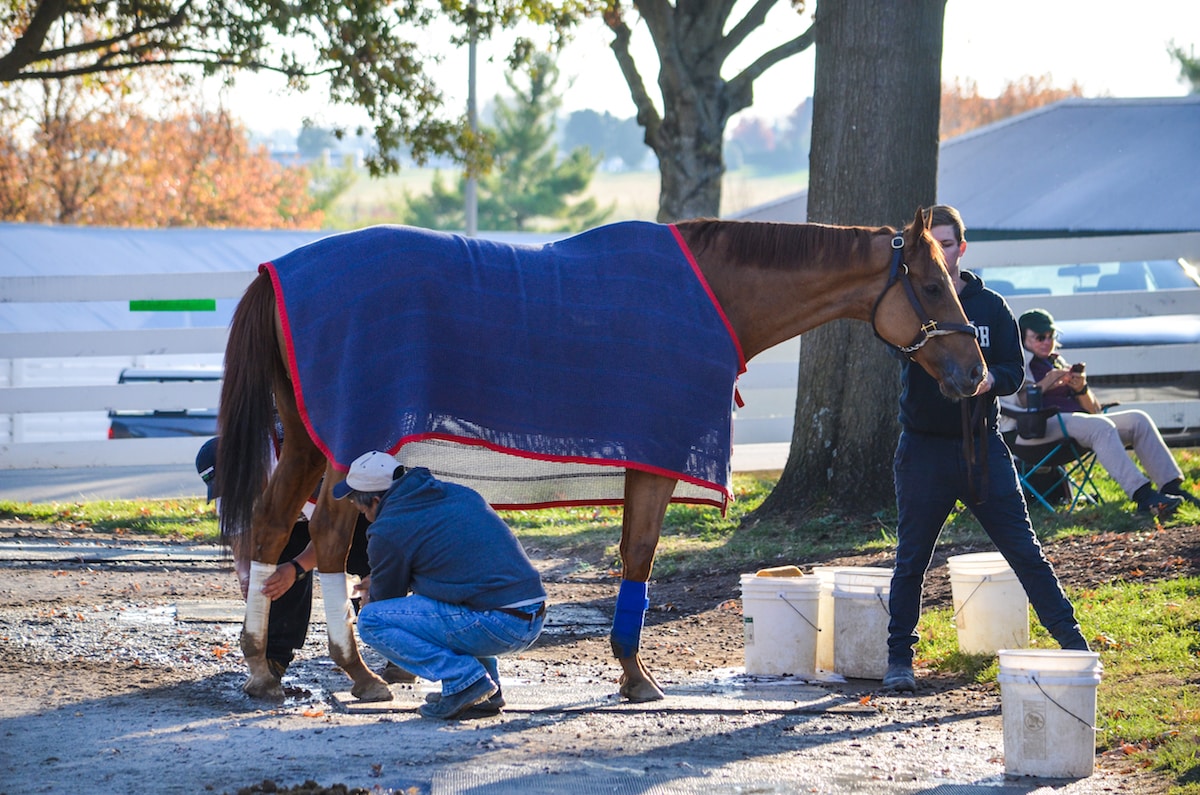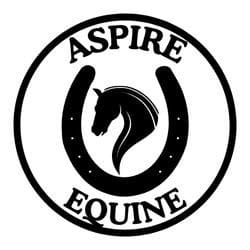Steps trainers and grooms take to help racehorses cool down and recover after a strenuous workout or race

Pyrois Media/Melissa Bauer-Herzog
After a ride, we don’t simply pull off our tack, lead our horses back to their stalls and call it a day. We likely have a routine that gives us more time with our horses while allowing them to cool down from whatever exercise that day brought.
Racehorses follow a particularly rigorous recovery pattern after a race or a fast workout. In a large barn horses might be handed off to several people for each part of that routine, which is designed to allow them to cool down both physically and mentally.
The Initial Cool-Down
Michele Dollase trains horses at San Luis Rey Training Center, in Southern California. Other trainers rely on her to start their young horses at the track or care for them during layups (when horses are in lighter training, often while recuperating from minor injuries). Dollase has also worked as an equine physical therapist.
She says that while horses need to recover physically after a race or workout, the psychological aspect is just as important. Their adrenaline has been pumping, and sometimes it takes a while to adjust mentally from a full-out sprint to hand-walking back at the barn, she explains.
“They come back after a race, and they need to cool out,” Dollase says. “They’re really breathing after a race — they’ve run hard. You’re going to give them that time.”
Same goes after a hard or fast work. If you don’t cool racehorses out properly, she says, they can tie up, experiencing exercise-associated muscle damage that manifests as sweating, refusing to move and muscle spasms.
Dollase is especially careful when training young horses that have just been asked for their first bursts of speed. After young horses have spent time getting fit through long gallops on the racetrack, trainers ask them for short, fast works similar to what they will eventually do in a race.
Immediately after horses work or race, they return to their barn unless they have been designated for post-race urine sampling for a drug test. If it’s a race, the horse’s groom leads the horse back to the barn while the jockey returns to the jockeys’ room to get ready for the next race. If it’s a morning workout, the exercise rider rides the horse all the way back to the barn.
Depending on how many employees a trainer has, the horse’s groom or a hot-walker hand-walks the horse to cool him down. Some trainers use a hot-walking machine, though most prefer a person, who can watch the horse he or she is leading closely for any problems.
Following a routine gallop, horses receive a bath or a sponge-down and then get hand-walked until they’ve cooled out completely.
“We give them an extra 10 minutes to kind of catch their breath before we give them a bath,” says Dollase. “They get 10 minutes of walking, and they are watered off — five swallows only, and then they take another turn” walking.
While watering practices vary from trainer to trainer, Dollase learned the five-swallow lesson from her late father, trainer Wally Dollase. That amount of water keeps the horse hydrated, she says, without shocking his system.
“It’s the same as with a human,” Dollase says. “If you drink too much (after strenuous activity), you might get a stomachache.”
Hot-walkers usually lead their charges around a fairly small circular path outside the barn or along a covered shedrow. After each circle, Dollase’s staff offers the horse those five swallows of water.
“I watch how they are breathing, their nostrils, how much they are sweating, how hot they’ve gotten,” she says. “You’re also looking for soundness, making sure they are walking correctly.”
Only after the horse has cooled down and is breathing more normally does he receive his bath.
“We give them a full bath after a work or a race,” says Dollase. “Sometimes after a gallop we just sponge them off, because I feel with a bath every day, they could catch a chill. I don’t clip my horses, so there’s a lot of hair on a lot of them. They take longer to cool out, and I don’t want to put horses back into their stalls when they are wet.”
Her horses then get another 30 minutes or so of walking until they are dry and can return to their stalls. The grooms or hot-walkers then allow the horses to drink water free-choice.
“You do want horses to drink a lot of water because you don’t want dehydration,” says Dollase. “I’m always watching the manure (quality) of my horses to be sure it’s not too loose or too dry.”
Dollase uses some of the same tricks the rest of us do to get horses to drink more if needed, such as offering salt or electrolytes.
“We always want to monitor how much water the horses are drinking,” she says, noting that she opts to not use automatic waterers. “I have employees watching the horses 24/7 in the barn, so they can always add water to the buckets. We keep two buckets in each stall.”
Back in the Barn
When a horse returns to his stall, Dollase and her crew try to encourage him to urinate, often by whistling. It’s a racetrack training technique that comes in handy for post-race drug testing. If officials select a horse for testing, he goes to a special barn and cannot return to his stall until the tester collects a urine sample. If he’ll essentially urinate on command, it saves time and hassle for all involved.
Next, the horses get time to relax. Dollase feeds her horses timothy hay in a haynet hung just outside the stall door and gives them about an hour to unwind. She leaves the top halves of the stall doors open so the horses can access the hay and poke their heads out and watch the barn activity. This helps them stay involved with what’s going on, she says, and they might be less prone to develop behavioral vices due to boredom.
Grooms work on the horses’ legs after that downtime. Trainers determine what treatment is best for each horse, depending on his individual needs and where he is in his training.
Dollase frequently has her grooms apply a medicated poultice to the horses’ legs, sometimes after icing them. She uses gel ice boots, though some barns still stand horses in buckets of ice water the traditional way. Both the ice and the poultice help draw heat out of a horse’s legs and proactively inhibit inflammation.
Standing bandages go over the poultice, which Dollase leaves on overnight. The grooms wash off the poultice the next morning. The day following a race or a fast workout, the horse simply gets hand-walked in the shedrow — another way to give his body a chance to rest and recuperate.
Sometimes Dollase alternates a medicated poultice with heat treatments or rubbing alcohol under the bandages, depending on what the horse needs. The heat treatment, sometimes called a sweat, is usually a salve such as nitrofurazone, which generates heat to reduce fluid buildup in the legs. In those cases a groom bandages the horse in lightweight plastic wrap, sheet cotton and then the standing bandage.
Additional Tools
In the days between fast works or races, trainers might use a variety of therapeutic treatments to keep horses feeling their best. These range from acupuncture, chiropractic care and massage to some of the various therapeutic machines available. Dollase is trained in using an electro-acuscope/myopulse therapy system (to help stimulate muscles, tendons and ligaments and reduce pain and inflammation), which provides her with data she can use as one more tool when deciding each horse’s next training step.
Every approach is designed to help equine athletes be at their best when they compete so they can stay comfortable, sound and ultimately reach the winner’s circle.
This article was originally published in the Spring 2019 issue of Off-Track Thoroughbred Magazine, the only publication dedicated to the Thoroughbred ex-racehorse in second careers. Want four information-packed issues a year delivered to your door or your favorite digital device? Subscribe now!

